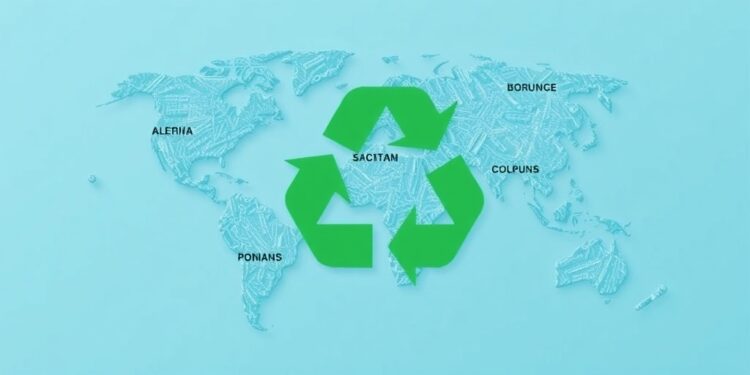In the rapidly evolving landscape of global plastic production, a stark reality has emerged from the latest findings, revealing that only 9.5% of plastic materials produced worldwide in 2022 were derived from recycled sources. This disheartening statistic draws attention to the urgent need for sustainable practices within the plastics industry, as highlighted in a comprehensive analysis published in Communications Earth & Environment. The report brings to light critical insights regarding the surge in plastic waste disposal methods such as incineration while underscoring the pronounced regional disparities around plastic consumption.
The narrative of plastic production paints a dramatic picture: from a mere two million tonnes produced annually back in 1950, the figure has skyrocketed to an astounding 400 million tonnes in 2022, with projections forecasting a further escalation to 800 million tonnes by the year 2050. Such relentless growth not only symbolizes human innovation but also surfaces pressing environmental, economic, and public health challenges that echo globally. As the production of plastics continues unabated, concerns surrounding plastic pollution take center stage, demanding sophisticated analyses that have largely been absent from traditional discourse on the global plastics sector.
Under the leadership of researcher Quanyin Tan and a dedicated team, an extensive examination of the global plastics industry was undertaken in 2022, leveraging a diverse array of data from national statistics, industry reports, and international databases. This investigative effort culminated in a detailed overview of plastic production, usage, and disposal across various regions. The findings are indeed alarming: out of the total 400 million tonnes of plastic produced, less than 38 million tonnes (or 9.5%) was sourced from recycled plastic materials. The overwhelming majority—98% of the remainder—was manufactured from fossil fuels, notably coal and oil, painting a troubling picture of dependency on non-renewable resources.
Disposal statistics further exacerbate concerns over the sustainability of the plastics lifecycle. Approximately 268 million tonnes of plastic were discarded over the course of the year, with only 27.9% of that plastic sent for sorting and potential recycling. The remaining plastic largely followed a grim fate: 36.2% ended up in landfills, while a significant 22.2% was incinerated. Alarmingly, even among plastic that was sorted for recycling, only half was successfully processed; a substantial portion—41% ended up incinerated, and another 8.4% was relegated to landfills. Although there has been a slight decrease in the percentage of overall global plastic waste allocated to landfills—from an estimated 79% between 1950 and 2015 to 40% in 2022—this decline does little to obscure the growing crisis at hand.
Regionally, the statistics exhibit remarkable variability, with the United States reporting the highest per capita plastic consumption at an average of 216 kilograms per person per year. In stark contrast, China emerged as the largest overall consumer, with an overwhelming annual consumption of 80 million tonnes of plastic. Such disparities not only reflect differences in population but also underscore varying degrees of economic development, industrial capacity, and regulatory environments pertaining to plastic usage and waste management.
The urgency of addressing plastic pollution cannot be overstated. Beyond environmental degradation, plastic waste has significant implications for public health and economic sustainability. As plastic products infiltrate ecosystems and food chains, the risks to biodiversity and human health grow ominously. Yet, despite the daunting realities presented in this research, the authors emphasize the pivotal role that such studies can play in shaping effective policies and regulations moving forward.
There exists a critical need for comprehensive policy frameworks that can appropriately guide plastic production, consumption, and waste management. Future regulations should aim to not only incentivize recycling and the use of recycled materials but also implement strict measures on plastic production from virgin materials. Innovative approaches, such as enhancing waste sorting technologies and increasing public awareness surrounding plastic recycling, could significantly alter the trajectory of plastic waste. This pivotal study serves as a foundational step in piecing together the complexities of the global plastics supply chain, revealing both the challenges and opportunities that lie ahead.
Moreover, as consumer awareness regarding environmental issues grows, there is a burgeoning demand for sustainable practices among both manufacturers and consumers. The study underscores that manufacturers must pivot towards developing biodegradable materials or investing in technologies that facilitate recycling. Additionally, consumer behaviors can evolve to preference products made from recycled materials, thereby creating a market incentive for companies to rethink their supply chains.
The pressing need for global coalitions to tackle plastic pollution further highlights the interconnected nature of this challenge. Nations must collaborate to create harmonized regulations that can effectively address plastic waste across borders, as plastic pollution knows no geographical bounds. Such collaborations may involve sharing research, technologies, and best practices that lead to optimized waste management systems worldwide.
Ultimately, the findings of this analysis extend beyond mere statistics; they represent a call to action for governments, industries, and communities to usher in a new era of environmental responsibility. While the challenges are formidable, the pathway to sustainable materials management is illuminated by this critical research, outlining the immediate steps required to mitigate the devastating impacts of plastic pollution. Our collective future hinges on the choices made today regarding plastic production and consumption, and this study serves as a clarion call for urgent and concerted action.
The key insights and implications presented in this research are paramount as we navigate the complexities of modern plastic production and waste disposal. By pursuing innovative solutions, fostering collaborative efforts, and initiating progressive policies, we can turn the tide against the burgeoning crisis of plastic pollution and protect our planet for future generations.
Subject of Research: Not applicable
Article Title: Complexities of the global plastics supply chain revealed in a trade-linked material flow analysis
News Publication Date: 10-Apr-2025
Web References: 10.1038/s43247-025-02169-5
References: Not applicable
Image Credits: Not applicable
Keywords: Plastic Production, Recycling, Global Plastics Sector, Environmental Policy, Plastic Pollution, Waste Management, Sustainability, Fossil Fuels, Economic Impact, Public Health, Regional Disparities, Collaborative Efforts.




